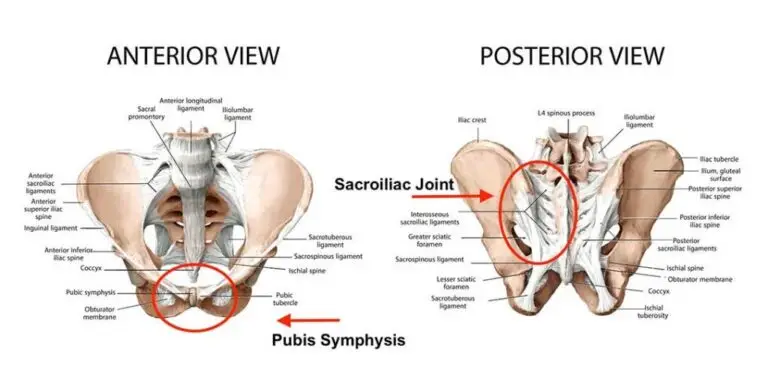Sacroiliac Joint
Introduction
The sacroiliac joint is a crucial yet often overlooked component of the spine and pelvis. It plays a vital role in distributing forces between the upper body and the lower extremities. However, when this joint becomes inflamed or dysfunctional, it can lead to persistent discomfort, commonly referred to as pain in the sacroiliac joint. This article explores the anatomy of the sacroiliac joint, how it contributes to pain, and various treatment options available for relief.
Anatomy of the Sacroiliac Joint
Related Topics:
The sacroiliac joint (SI joint) is located at the base of the spine, connecting the sacrum to the iliac bones of the pelvis. Humans have two SI joints—one on each side of the sacrum.
Structure of the Sacroiliac Joint
-
Bones: The SI joint is where the sacrum, a triangular bone at the base of the spine, meets the ilium, which forms the upper portion of the pelvis.
-
Ligaments: The joint is reinforced by strong ligaments, including the anterior and posterior sacroiliac ligaments, sacrotuberous ligament, and sacrospinous ligament. These provide stability and limit excessive movement.
-
Cartilage: The SI joint has a small amount of cartilage covering its articular surfaces. This helps absorb shock and reduce friction between the bones.
-
Joint Capsule: A fibrous capsule encloses the joint, containing synovial fluid that lubricates and facilitates smooth movement.
Function of the Sacroiliac Joint
The sacroiliac joint serves as a shock absorber, transferring weight and forces from the spine to the legs. It also provides slight motion, allowing for flexibility during activities such as walking, running, and bending. However, excessive or insufficient movement in this joint can contribute to sacroiliac joint tenderness and pain.
Types of Sacroiliac Joint Dysfunction
Hypermobility (Instability) – Excessive movement in the SI joint can cause inflammation and pain, often leading to difficulty maintaining posture and balance.
Hypomobility (Fixation or Stiffness) – A lack of mobility in the SI joint can lead to compensatory pain in the lower back, hips, or legs.

Causes of Pain in the Sacroiliac Joint
Pain arising from the sacroiliac joint can be acute or chronic and is typically associated with instability, inflammation, or mechanical dysfunction.
Common Causes of Sacroiliac Joint Pain
Trauma – Falls, car accidents, or direct impact to the lower back or pelvis can disrupt the alignment of the SI joint.
Pregnancy – Hormonal changes during pregnancy cause ligament laxity, increasing the mobility of the sacroiliac joint, leading to discomfort.
Arthritis – Conditions like osteoarthritis or ankylosing spondylitis can cause degeneration or inflammation in the SI joint.
Gait Abnormalities – Uneven leg length, scoliosis, or poor posture can place excessive stress on one or both SI joints.
Repetitive Stress – Prolonged activities such as running, heavy lifting, or standing for long periods can contribute to wear and tear.
Post-Surgical Changes – Spinal surgeries such as lumbar fusions alter load distribution, sometimes causing excessive strain on the SI joint.
Infections or Autoimmune Disorders – Less commonly, infections or inflammatory diseases like psoriatic arthritis or lupus can affect the sacroiliac joint.
Additional Risk Factors for SI Joint Pain
-
Obesity – Excess weight puts additional stress on the SI joints, increasing the risk of dysfunction.
-
Sedentary Lifestyle – Lack of movement can lead to stiffness and decreased flexibility in the SI joint region.
-
High-Impact Activities – Sports or physical labor that involve repetitive movements can strain the SI joint over time.
Symptoms of Sacroiliac Joint Dysfunction
Individuals experiencing pain in the sacroiliac joint often report:
-
-
Lower back pain localized to one side
-
Pain that worsens with standing, walking, or transitioning from sitting to standing
-
Stiffness and reduced mobility in the pelvis and lower back
-
Tenderness over the SI joint, particularly when pressing on the area, often at Fortin’s point, a region just medial and inferior to the posterior superior iliac spine (PSIS), which is commonly used as a clinical indicator of sacroiliac joint dysfunction.
-
Pain radiating down the leg, mimicking sciatica, but typically stopping at the level of the knee, distinguishing it from true sciatic nerve pain.
-
Difficulty sleeping due to discomfort in the lower back or hips
-

Complications of Pain in the Sacroiliac Joint
Related Topics:
Sacroiliac joint dysfunction can sometimes contribute to the development of piriformis syndrome, a condition where the piriformis muscle, located deep in the buttocks, compresses the sciatic nerve. When the SI joint is unstable or inflamed, it can alter biomechanics, leading to excessive strain on the piriformis muscle. This can result in pain, muscle tightness, and sciatic nerve irritation, further complicating the symptoms of sacroiliac joint dysfunction.
Diagnosing Sacroiliac Joint Pain
A proper diagnosis is essential to distinguish sacroiliac joint tenderness from other sources of back pain, such as herniated discs or hip disorders.
Clinical Examination
Doctors evaluate SI joint pain through:
-
- Physical tests, such as the FABER test, Gaenslen’s test, thigh thrust test, and compression/distraction tests, to provoke pain, assess mobility, and evaluate joint stability.
- Palpation, pressing over the SI joint to identify localized sacroiliac joint tenderness.
- Gait and posture analysis, assessing asymmetry or misalignment.
Imaging Tests
-
- X-rays – Identify arthritis or structural changes.
- MRI scans – Detect inflammation or soft tissue damage.
- CT scans – Provide a detailed view of joint alignment and possible fractures.
Diagnostic Injections
A sacroiliac joint injection with local anesthetic can help confirm the diagnosis. If pain subsides after the injection, the SI joint is likely the source of discomfort.
Treatment for Sacroiliac Joint Pain
Treatment depends on the severity of pain in the sacroiliac joint and whether the cause is mechanical, inflammatory, or degenerative.
Conservative Treatments
-
- Rest and Activity Modification – Avoiding prolonged standing, heavy lifting, or uneven weight distribution can reduce strain.
- Physical Therapy – Strengthening the core, pelvis, and hip muscles stabilizes the SI joint.
- Stretching Exercises – Targeted stretches improve flexibility and reduce stiffness.
- Pain Medication – NSAIDs (ibuprofen, naproxen) or acetaminophen can relieve inflammation and discomfort.
- SI Joint Belts – External bracing provides stability for hypermobile SI joints.
- Chiropractic Care – Some patients benefit from manual adjustments to realign the SI joint.

Interventional Treatments
-
- Sacroiliac Joint Injections – A combination of corticosteroids and anesthetics helps reduce inflammation and confirm diagnosis.
- Radiofrequency Ablation (RFA) – Uses heat to disrupt pain signals from SI joint nerves, providing longer-lasting relief.
- Platelet-Rich Plasma (PRP) or Stem Cell Therapy** – Emerging treatments aimed at regenerating damaged joint tissues.
Surgical Treatments
For persistent pain unresponsive to conservative therapy, surgical options may be considered:
- SI Joint Fusion – A minimally invasive procedure that stabilizes the joint by fusing the sacrum and ilium together using implants.
Conclusion
If you are experiencing persistent pain in the sacroiliac joint, don’t wait to seek relief. At Red Butte Pain Solutions, we specialize in diagnosing and treating SI joint pain with effective, personalized care. Call us today at 602-633-4334 or schedule an appointment online to start your journey toward lasting pain relief.
The sacroiliac joint plays a pivotal role in stability and movement, but when dysfunction arises, it can lead to persistent pain. Understanding the anatomy, common causes, and treatment options for pain in the sacroiliac joint helps patients make informed decisions about their health.
Sacroiliac Joint Exercises for Lasting Pain Relief
Sacroiliac joint (SIJ) pain is a common condition that affects the lower back and pelvis. It often results from dysfunction in the sacroiliac joints, which connect the sacrum to the iliac bones. Many individuals with SIJ pain experience discomfort when sitting,...
Are Fused Sacroiliac Joints the Answer?
The sacroiliac (SI) joints connect the spine to the pelvis, providing stability and absorbing shock. When these joints become dysfunctional due to injury, arthritis, or instability, patients can experience chronic pain in the lower back, buttocks, and legs. For some,...
The Connection Between Hip Pain and Back Pain
When I was a kid, there was a song called "The Skeleton Dance" where we sang, "The foot bone's connected to the leg bone. The leg bone's connected to the knee bone..." and so on. This simple, catchy tune shows how the body’s structures are biomechanically connected. I...
Sacroiliac Joint Pain: A Real Pain in the…
Sacroiliac (SI) joint pain can be a frustrating and debilitating condition that affects your lower back, hips, and legs. For many people in Arizona, sacroiliac joint pain interferes with daily activities, making it difficult to sit, sleep, or move comfortably. At Red...
